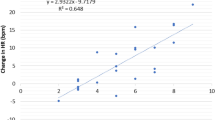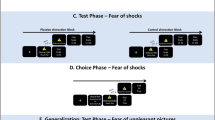Abstract
We explored the effects of uncontrollability and subjective helplessness (SHL) on perceived pain intensity (PPI) in 64 healthy men randomly assigned to groups receiving controllable (C) or uncontrollable (UC) painful electric skin stimuli. SHL (d = 1.43), perceived unpleasantness (d = 1.03), and PPI (d = 0.58) were more pronounced in the UC group than in the C group. Multiple regression and bootstrap analyses for testing mediation showed a direct relationship between stressor uncontrollability and PPI (r = 0.28; P < .05), which disappeared when adjusted for the SHL increase (β = 0.49, P < .001). SHL changes were associated with objective uncontrollability (r = 0.59, P < .001). PPI and unpleasantness were positively correlated (r = 0.37, P < .01). The study suggests that the effect of objective controllability on pain intensity ratings is mediated mainly by ratings of SHL.



Similar content being viewed by others
References
Abramson, L. Y., Teasdale, J. D., & Seligman, M. E. P. (1978). Learned helplessness in humans: Critique and reformulation. Journal of Abnormal Psychology, 87, 49–74.
Amat, J., Aleksejev, R. M., Paul, E., Watkins, L. R., & Maier, S. F. (2010). Behavioral control over shock blocks behavioral and neurochemical effects of later social defeat. Neuroscience, 165, 1031–1038.
Bär, K. J., Brehm, S., Boettger, M. K., Boettger, S., Wagner, G., & Sauer, H. (2005). Pain perception in major depression depends on pain modality. Pain, 117, 97–103.
Berna, C., Leknes, S., Holmes, E. A., Edwards, R. R., Goodwin, G. M., & Tracey, I. (2010). Induction of depressed mood disrupts emotion regulation neurocircuitry and enhances pain unpleasantness. Biological Psychiatry, 67, 1083–1090.
Brunstein, J. C. (1986). Attributionsstil und Depression; erste Befunde zur Reliabilität und Validität eines deutschsprachigen Attributionsstilfragebogens. Zeitschrift für Differentielle Psychologie und Diagnostik, 7, 45–53.
Burns, J. W., Elfant, E., & Quartana, P. J. (2010). Suppression of pain-related thoughts and feelings during pain-induction: Sex differences in delayed pain responses. Journal of Behavioral Medicine, 33, 200–208.
Carlsson, K., Andersson, J., Petrovic, P., Petersson, K. M., Ohman, A., & Ingvar, M. (2006). Predictability modulates the affective and sensory-discriminative neural processing of pain. Neuroimage, 32, 1804–1814.
Cho, S., Heiby, E. M., McCracken, L. M., Lee, S. M., & Moon, D. E. (2010). Pain-related anxiety as a mediator of the effects of mindfulness on physical and psychosocial functioning in chronic pain patients in Korea. Journal of Pain, 11, 789–797.
Christianson, J. P., Ragole, T., Amat, J., Greenwood, B. N., Strong, P. V., Paul, E. D., et al. (2010). 5-hydroxytryptamine 2C receptors in the basolateral amygdala are involved in the expression of anxiety after uncontrollable traumatic stress. Biological Psychiatry, 67, 339–345.
Christianson, J. P., Thompson, B. M., Watkins, L. R., & Maier, S. F. (2009). Medial prefrontal cortical activation modulates the impact of controllable and uncontrollable stressor exposure on a social exploration test of anxiety in the rat. Stress, 12, 445–450.
Courvoisier, D. S., & Perneger, T. V. (2010). Validation of alternative formulations of job strain. Journal of Occupational Health, 52, 5–13.
Derbyshire, S. W., Jones, A. K., Gyulai, F., Clark, S., Townsend, D., & Firestone, L. L. (1997). Pain processing during three levels of noxious stimulation produces differential patterns of central activity. Pain, 73, 431–445.
Drugan, R. C., Ader, D. N., & Maier, S. F. (1985). Shock controllability and the nature of stress-induced analgesia. Behavioral Neurosciences, 99, 791–801.
Drugan, R. C., Basile, A. S., Ha, J. H., Healy, D., & Ferland, R. J. (1997). Analysis of the importance of controllable versus uncontrollable stress on subsequent behavioral and physiological functioning. Brain Research and Brain Research Protocols, 2, 69–74.
Erdmann, G., & Jahnke, W. (2008). SVF—Stressverarbeitungsfragebogen: Stress, Stressverarbeitung und ihre Erfassung durch ein mehrdimensionales Testsystem, 4.A. Göttingen: Hogrefe.
Foster, N. E., Bishop, A., Thomas, E., Main, C., Horne, R., Weinman, J., et al. (2008). Illness perceptions of low back pain patients in primary care: What are they, do they change and are they associated with outcome? Pain, 136, 177–187.
Janke, W., & Debus, G. (1978). EWL–Eigenschaftswörterliste. Eine mehrdimensionale Methode zur Beschreibung von Aspekten des Befindens. Göttingen: Hogrefe Verlag.
Kimmel, H. D., King, J., Hudy, J. J., & Gardner, K. A. (1980). A mutual inductance shocker. Behavioral Research Methods and Instrumentation, 12, 605–606.
Lazarus, R. S. (1991). Emotion and adaptation. New York: Oxford University Press.
Lazarus, R. S., & Folkman, S. (1987). Transactional theory and research on emotions and coping. European Journal of Personality, 1, 141–170.
Maier, S. F. (1986). Stressor controllability and the nature of stress-induced analgesia. Annals of the New York Academy of Sciences, 467, 55–72.
Maier, S. F., Drugan, R. C., & Grau, J. W. (1982). Controllability, coping behavior, and stress-induced analgesia in the rat. Pain, 12, 47–56.
Meredith, P. J., Strong, J., & Feeney, J. A. (2006). The relationship of adult attachment to emotion, catastrophizing, control, threshold and tolerance, in experimentally-induced pain. Pain, 120, 44–52.
Mohr, C., Leyendecker, S., & Helmchen, C. (2008). Dissociable neural activity to self- vs. externally administered thermal hyperalgesia: A parametric fMRI study. European Journal of Neuroscience, 27, 739–749.
Müller, M. J. (1998). Bedeutung und Prävalenz subjektiver Unkontrollierbarkeit und Hilflosigkeit bei gesunden männlichen Probanden. Psychologische Beiträge, 40, 328–339.
Müller, M. J., & Netter, P. (1992). Unkontrollierbarkeit und Leistungsmotivation–Einflüsse auf Cortisol- und Testosteronkonzentrationsänderungen während einer mental-leistungsbezogenen und einer physisch-aversiven Belastungssituation. Zeitschrift für Medizinische Psychologie, 1, 103–113.
Müller, M. J., & Netter, P. (2000). Relationship of subjective helplessness and pain perception after electric skin stimuli. Stress Medicine, 16, 109–115.
Oka, S., Chapman, C. R., Kim, B., Shimizu, O., Noma, N., Takeichi, O., et al. (2010). Predictability of painful stimulation modulates subjective and physiological responses. Journal of Pain, 11, 239–246.
Osman, A., Barrios, F. X., Gutierrez, P. M., Kopper, B. A., Merrifield, T., & Grittmann, L. (2000). The Pain Catastrophizing Scale: Further psychometric evaluation with adult samples. Journal of Behavioral Medicine, 23, 351–365.
Palomino, R. A., Nicassio, P. M., Greenberg, M. A., & Medina, E. P., Jr. (2007). Helplessness and loss as mediators between pain and depressive symptoms in fibromyalgia. Pain, 129, 185–194.
Peterson, C., Maier, S. F., & Seligman, M. E. P. (1995). Learned helplessness. A theory for the age of personal control. New York: Oxford University Press.
Peterson, C., Semmel, A., Metalsky, G., Abramson, L. Y., Baeyer, C., & Seligman, M. E. P. (1982). The attribution style questionnaire. Cognitive Therapy Research, 6, 287–300.
Piñerua-Shuhaibar, L., Villalobos, N., Delgado, N., Rubio, M. A., & Suarez-Roca, H. (2011). Enhanced central thermal nociception in mildly depressed nonpatients and transiently sad healthy subjects. Journal of Pain, 12, 360–369.
Poppe, P., Stiensmeier-Pelster, J., & Pelster, A. (2005). ASF-E—Attributionsstilfragebogen für Erwachsene. Göttingen: Hogrefe Verlag.
Preacher, K. J., & Hayes, A. F. (2008). Asymptotic and resampling strategies for assessing and comparing indirect effects in multiple mediator models. Behavior Research Methods, 40, 879–891.
Preacher, K. J., Rucker, D. D., & Hayes, A. F. (2007). Addressing moderated mediation hypotheses: Theory, methods, and prescriptions. Multivariate Behavioral Research, 42, 185–227.
Salomons, T. V., Johnstone, T., Backonja, M. M., & Davidson, R. J. (2004). Perceived controllability modulates the neural response to pain. Journal of Neuroscience, 24, 7199–7203.
Salomons, T. V., Johnstone, T., Backonja, M. M., Shackman, A. J., & Davidson, R. J. (2007). Individual differences in the effects of perceived controllability on pain perception: Critical role of the prefrontal cortex. Journal of Cognitive Neurosciences, 19, 993–1003.
Samwel, H. J., Evers, A. W., Crul, B. J., & Kraaimaat, F. W. (2006). The role of helplessness, fear of pain, and passive pain-coping in chronic pain patients. Clinical Journal of Pain, 22, 245–251.
Seligman, M. E. P. (1975). Helplessness, on depression, development and death. San Francisco: Freeman and Company.
Strigo, I. A., Simmons, A. N., Matthews, S. C., Craig, A. D., & Paulus, M. P. (2008). Increased affective bias revealed using experimental graded heat stimuli in young depressed adults: Evidence of “emotional allodynia”. Psychosomatic Medicine, 70, 338–344.
Sullivan, M. J. L., Bishop, S., & Pivik, J. (1995). The Pain Catastrophizing Scale: Development and validation. Psychological Assessment, 7, 432–524.
Tanaka-Matsumi, J., & Kameoka, V. A. (1986). Reliabilities and concurrent validities of popular self-report measures of depression, anxiety and social desirability. Journal of Consulting and Clinical Psychology, 54, 328–333.
Taylor, J. A. (1953). A personality scale of manifest anxiety. Journal of Abnormal Social Psychology, 18, 285–290.
Thompson, S. C. (1981). Will it hurt less if I can control it? A complex answer to a simple question. Psychological Bulletin, 90, 89–101.
Turk, D. C., & Feldman, C. S. (1992). Noninvasive approaches to pain control in terminal illness: The contribution of psychological variables. Hospital Journal, 8, 1–23.
Turk, D. C., Meichenbaum, D., & Genest, M. (1983). Pain and behavioral medicine: A cognitive behavioral perspective. New York: Guilford Press.
Villemure, C., & Bushnell, M. C. (2009). Mood influences supraspinal pain processing separately from attention. Journal of Neuroscience, 29, 705–715.
Wager, T. D., Matre, D., & Casey, K. L. (2006). Placebo effects in laser-evoked pain potentials. Brain, Behavior, and Immunity, 20, 219–230.
Wiech, K., Kalisch, R., Weiskopf, N., Pleger, B., Stephan, K. E., & Dolan, R. J. (2006). Anterolateral prefrontal cortex mediates the analgesic effect of expected and perceived control over pain. Journal of Neuroscience, 26, 11501–11509.
Wittchen, H. U., Zaudig, M., & Fydrich, T. (1997). Strukturiertes Klinisches Interview für DSM-IV (SKID). Göttingen: Hogrefe.
Author information
Authors and Affiliations
Corresponding author
Rights and permissions
About this article
Cite this article
Müller, M.J. Will it hurt less if I believe I can control it? Influence of actual and perceived control on perceived pain intensity in healthy male individuals: a randomized controlled study. J Behav Med 35, 529–537 (2012). https://doi.org/10.1007/s10865-011-9382-0
Received:
Accepted:
Published:
Issue Date:
DOI: https://doi.org/10.1007/s10865-011-9382-0




